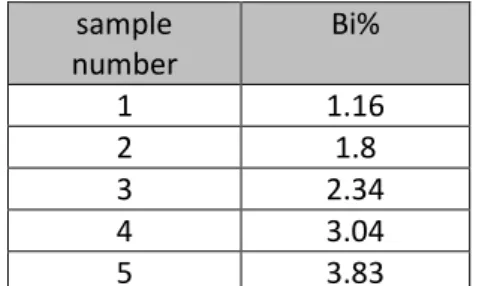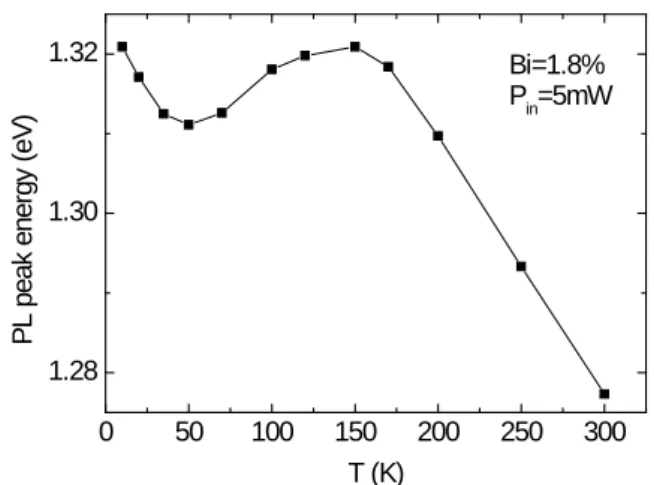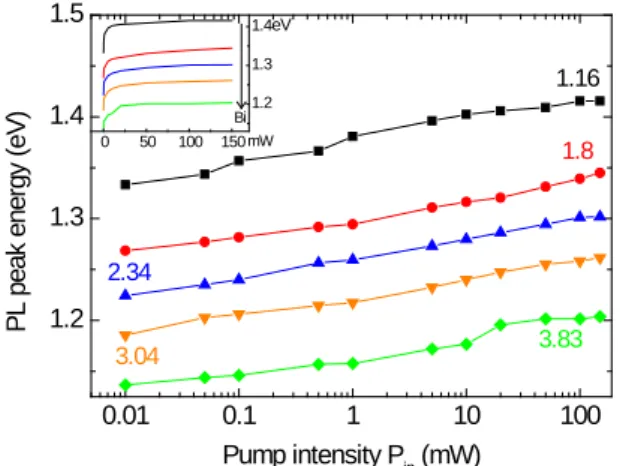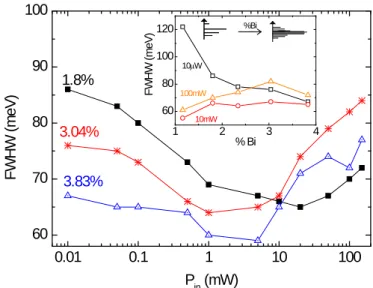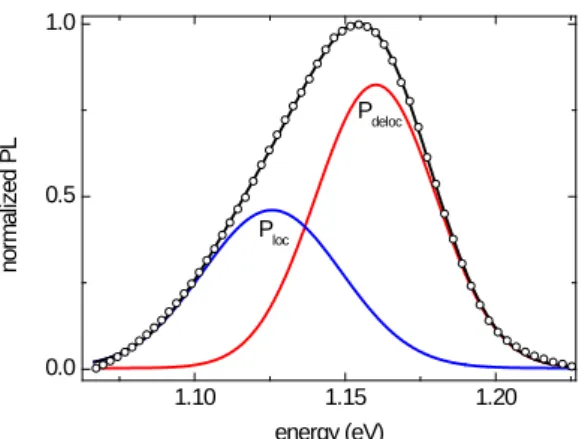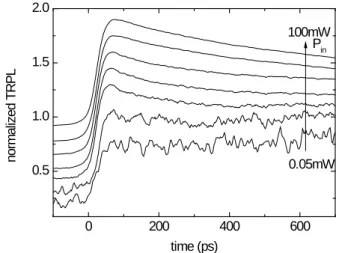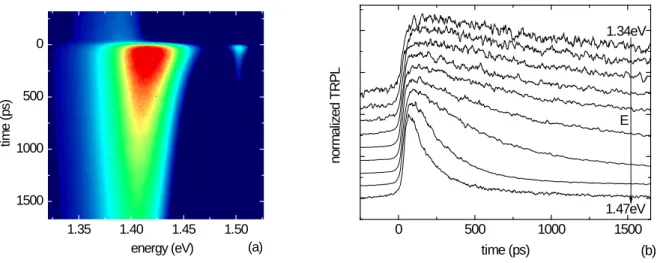HAL Id: hal-01943032
https://hal.laas.fr/hal-01943032
Submitted on 4 Feb 2019HAL is a multi-disciplinary open access archive for the deposit and dissemination of sci-entific research documents, whether they are pub-lished or not. The documents may come from teaching and research institutions in France or abroad, or from public or private research centers.
L’archive ouverte pluridisciplinaire HAL, est destinée au dépôt et à la diffusion de documents scientifiques de niveau recherche, publiés ou non, émanant des établissements d’enseignement et de recherche français ou étrangers, des laboratoires publics ou privés.
Low-temperature photoluminescence study of exciton
recombination in bulk GaAsBi
Simone Mazzucato, Henri Lehec, Hélène Carrère, Hajer Makhloufi, Alexandre
Arnoult, Chantal Fontaine, Thierry Amand, Xavier Marie
To cite this version:
Simone Mazzucato, Henri Lehec, Hélène Carrère, Hajer Makhloufi, Alexandre Arnoult, et al.. Low-temperature photoluminescence study of exciton recombination in bulk GaAsBi. Nanoscale Research Letters, SpringerOpen, 2014, 9 (19), �10.1186/1556-276X-9-19�. �hal-01943032�
1
Low-temperature photoluminescence study of exciton
recombination in bulk GaAsBi
S Mazzucato1,a, H Lehec1, H Carrère1, H Makhloufi2,3, A Arnoult2,3, C Fontaine2,3, T Amand1, and X Marie1
1
Université de Toulouse, LPCNO, INSA-UPS-CNRS, 135 avenue de Rangueil, F-31400 Toulouse, France
2
LAAS-CNRS, 7 avenue du Colonel Roche, F-31400 Toulouse, France
3
Université de Toulouse, F-31400 Toulouse, France
Keywords
Dilute bismides, carrier localization, exciton dynamics, GaAsBi, s-shape
Abstract
The exciton recombination processes in a series of elastically strained GaAsBi epilayers is investigated by means of time integrated and time resolved photoluminescence at T=10K. The Bismuth content in the samples was adjusted from 1.16 to 3.83%, as confirmed by high resolution x-ray diffraction (HR-XRD). The results are well interpreted by carrier trapping and recombination mechanisms involving the Bi-related localized levels. Clear distinction between the localized and delocalized regime was observed in the spectral and temporal photoluminescence emission.
Background
Over the last few years, much attention has been paid to the growth and investigation of dilute bismides, with potential applications for high efficiency solar cells, and for optoelectronic devices in the 1–1.55-μm wavelength range [1-3].
Adding even a small amount of Bi to arsenides strongly affects the valence band structure and induces a significant lowering of their band gap energy, up to ~ 88 meV per percent of Bi [4], and a significant increase of the spin-orbit (SO) split-off energy, resulting from a valence band anticrossing behavior [5,6].
On the contrary, the conduction band is barely affected by the Bi atoms, but the electron spin properties, which depend critically on the SO interaction, can be tuned in dilute bismides, making them suitable candidates for spintronics applications. [7]
a
2 In addition, the incorporation of Bi yields a significant carrier localization in the valence band, affecting the band-to-band recombination energy and visible as a deviation from the Varshni curve at low temperature (S-shape), [8] in a similar way as observed in dilute nitrides [9,10]. The origin of this S-shape behavior is attributed to localized states due to alloy disorder, cluster formation and potential fluctuations in GaAsBi induced by Bi incorporation [11,12].
A study on the shallow localized states associated with Bi clusters near the top of the GaAsBi valence bandgap was performed by Lu et al. [13]. This study was done at room temperature, where thermal energy already masks most of the contribution of the shallowest levels. Here instead, we investigate the exciton dynamics in different GaAsBi epilayers at T=10K, as function of incident power, being able to distinguish between the localized and free carriers regime.
Methods
In this paper, we investigate a series of five bulk undoped GaAsBi samples, grown on a low-temperature (LT) grown-GaAs buffer layer and a semi-insulating GaAs (100) substrate in a RIBER solid-source molecular beam epitaxy system. The GaAsBi layer is elastically strained in all samples, and the corresponding Bi concentration is listed in Table 1. Both these information have been confirmed via HR-XRD. sample number Bi% 1 1.16 2 1.8 3 2.34 4 3.04 5 3.83
Table 1: Bi fraction of the investigated GaAsBi samples
The samples were mounted in a closed cycle He-cooled cryostat, where the temperature varied from 10 to 300K. Optical excitation was provided by focusing 1.5ps pulses generated by a mode-locked Ti-Sapphire laser with 80MHz repetition frequency. The laser wavelength was fixed at λexc=795nm to
allow both the GaAs and GaAsBi layer to be excited, and the beam was focused on a 50µm diameter spot at the sample surface. The incident power was varied by means of neutral density filters from 0.01 to 150mW, which corresponds to a typical photon flux at the sample surface from 2.5×1010 to 3.8×1014 cm-2, respectively. Assuming GaAsBi having the same absorption coefficient as GaAs, we estimate an average photon number absorbed in the GaAsBi layer from 109 to 1014 cm-3.
Time-integrated and time-resolved photoluminescence (PL), measured along the sample growth direction, were collected using a S1 photocathode Hamamatsu streak camera with an overall time resolution of 8ps, as a function of incident power and sample temperature.
3 Results and discussion
From the investigation of the GaAsBi PL peak emission energy versus temperature, a deviation of the obtained values from the expected Varshni fit is observed, especially at low excitation power densities (Figure 1). This feature, whose amplitude depends more upon the sample growth conditions than the Bi content [14], disappears when increasing the incident excitation power density due to the complete filling of the localized states, as previously reported [11,15].
0 50 100 150 200 250 300 1.28 1.30 1.32 P L peak ener gy ( eV ) T (K) Bi=1.8% Pin=5mW
Figure 1: GaAsBi PL peak emission energy as function of temperature for sample 2 (1.8% Bi), at 5 mW excitation power.
Due to the high localization effect observed at low temperature, investigation was focused on the PL behavior at T=10K as a function of laser incident power Pin. Figure 2 shows the PL spectra of all
samples taken at Pin=10 mW. 850 900 950 1000 1050 1100 1150 5 10 15 3.83 3.04 2.34 1.8 P L I nt ens ity ( a. u. ) Wavelength (nm) 1.16
Figure 2: Spectral PL emission of the investigated samples at Pin=10mW and T=10K, showing the energy bandgap shrinkage with increasing the Bi concentration.
The energy red-shift of the PL peak with increasing Bi% is clearly evidenced, in agreement with the literature results [4]. In our case, the amplitude of this shift is equal to about 75 meV/Bi%.
4 On the other side, a semilog plot of the PL peak energy versus Pin shows that the GaAsBi PL peak
blue-shifts with Pin in the same way for all samples. These results are extracted from the experimental
data reported in Figure 3.
0.01 0.1 1 10 100 1.2 1.3 1.4 1.5 Bi eV 3.83 3.04 2.34 1.8 P L peak ener gy ( eV ) Pump intensity Pin (mW) 1.16 mW 0 50 100 150 1.2 1.3 1.4
Figure 3: PL peak energy evolution as function of Pin. The inset shows the same graph in linear scale (the arrow shows the increasing Bi percentage).
Whereas the PL peak energy monotonically changes with the Bi fraction and Pin, a different
behavior is observed with the spectrum full width at half maximum (FWHM). Observation of the spectral broadening in Figure 2 suggests an increase of the FWHM with adding Bi. However this is true only at high excitation intensity, as it is shown in the inset of Figure 4, where there is a clear PL narrowing effect with Bi% at low Pin. This can be explained in terms of clustering effects and localized
exciton states induced by Bi incorporation. At low excitation power, the PL signal is dominated by localized exciton recombination, whose energy distribution shrinks with increasing Bi, moving from a set of quasi-discrete energy levels to a quasi-band formation with a larger density of states (see illustration in the top of Figure 4 inset), and hence resulting in an enhanced contribution to the PL spectrum.
With increasing the incident power, the localized levels saturate, giving rise to delocalized excitons and to an increase in the FWHM. This is probably due to inhomogeneous broadening caused by fluctuations in the local Bi composition, valence band potential and strain distribution, and eventually band filling.
5 0.01 0.1 1 10 100 60 70 80 90 100 3.83% 3.04% F WH W ( m e V ) Pin (mW) 1.8% 1 2 3 4 60 80 100 120 100mW 10mW F W H W ( m e V ) % Bi 10mW %Bi
Figure 4: PL spectral width (FWHM) evolution with excitation power for three samples. Inset: FWHM as a function of Bi fraction, for three excitation power densities; the scheme of Bi cluster state distribution is
drawn on the top of the inset.
The change in the FWHM with Pin is illustrated in Figure 4 for three samples, where the two
different processes depending on the Pin clearly appear. All five samples follow the same u-shaped
trend, with a minimum FWHM in the Pin region between 0.5 and 20mW, as already observed by Mazur
et al. [16] in GaAsBi QW samples under CW excitation power. The excitation power corresponding to this minimum for each sample will be referred as PMIN.
At low intensity, excitons tend to be highly localized, and cannot be separated so they recombine radiatively. By increasing Pin, filling of the localized states occurs, and delocalized excitons start
recombining, with the PL emission energy approaching the theoretical Varshni curve.
From previously reported Arrhenius plot in a similar sample, we observed that there is a continuous set of activation energies for these excitons (some of which can be cured by thermal annealing) [15]. Therefore, their contribution is expected to be always present, but predominant at the lowest Pin values.
In order to discriminate the contribution of delocalized and localized excitons, an efficient way consists in separating them in two families, in a similar way as reported by Mazur et al. [16], and fit all PL spectra by two Gaussians. Figure 5 shows for example the GaAsBi PL transition of sample 1, which is strongly asymmetric, together with the Gaussian fitting of the two exciton recombination related peaks.
6 1.10 1.15 1.20 0.0 0.5 1.0 Ploc nor m a liz ed P L energy (eV) Pdeloc
Figure 5: Fitting (black line) of the normalized PL spectrum of sample 5 (circles) with the sum of two Gaussian curves, corresponding to the localized (blue line) and to the delocalized (red line) exciton
contributions.
Figure 6 shows the evolution of the two Gaussian fitting curves as function of Pin. At low incident
power, the separation between their peak energies ΔE keeps constant, together with the ratio of their amplitude ID/IL; this indicates that carriers are well localized and delocalized excitons play a minor role.
With increasing Pin, excitons begin to delocalize and dominate in amplitude ID, and the hot carrier
population fills the density of states moving the two Gaussians apart. The FWHM, plotted in the inset of Figure 6, shows that the localized contribution has a flatter broadening over power compared to the delocalized excitons, but both Gaussians are always present and mixed all along the investigated power range. We are indeed aware that the exciton delocalization, even at higher Pin, is not complete, but
dominates over the localized contribution. This result confirms the strong exciton localization and alloy inhomogeneity present in GaAsBi alloys [17,18].
0.01 0.1 1 10 100 30 40 50 60 70 80 Pin (mW) ∆E ( m e V) 0 5 10 15 int ens ity r at io I D /IL 0.01 0.1 1 10 100 40 60 80 loc F W H M (me V ) Pin (mW) deloc
Figure 6: Evolution of the two Gaussian fitting curves as function of Pin, in terms of energy peak separation ΔE and intensity ratio. The inset shows the Pin dependence of the FWHM of the fits.
Another way to distinguish the localized and delocalized excitons is to check their time evolution after laser pulse excitation. An example of the power dependence of the TRPL curve sampled at the PL peak is shown in Figure 7. While at low Pin the carriers are frozen in the localized states (extremely long
7 decay time), at the highest Pin the PL decay times become shorter, confirming the saturation of these
states and the increase of the oscillator strength involved in the delocalized exciton recombination.
0 200 400 600 0.5 1.0 1.5 2.0 0.05mW 100mW nor m a liz ed T R P L time (ps) Pin
Figure 7: Power dependence of the TRPL curve measured at the PL peak for sample 5. Curves are shifted for clarity.
Again, the different exciton contributions can be spectrally separated, and this is evident when showing the streak camera image, together with the acquisition energy dependence of the PL decay curve taken at fixed excitation power, as represented in Figure 8. In Figure 8a, the GaAs TRPL transition is also visible above 1.5eV, and shows the fast decay time caused by the high defect density in the non-optimal grown LT-GaAs layer [15]. In Figure 8b, the GaAsBi PL decay is reported for different detection energies. As expected, the PL decay time increases when the detection energy decreases, due to carrier thermalization toward localized states, which are characterized by lower oscillator strength and hence longer recombination times. This observation is in good agreement with previously reported results on a similar GaAsBi sample [18]. For what concerns the GaAsBi transition, as expected, the population of hot carriers is established in the higher energy area, and correspondingly the PL signal decays on a short time scale. On the contrary, at lower energy the excitons are trapped in localized states and decay extremely slowly in time, indeed, it is much longer than the laser repetition rate, yielding a non-zero signal at t<0. Similar behavior in GaAsBi was reported by Imhof et al., [19] who investigated the luminescence dynamics with the help of Monte-Carlo simulation to incorporate two disorder scales attributed to alloy disorder and Bi-clustering.
8 0 500 1000 1500 nor m al iz ed T R P L time (ps) 1.47eV 1.34eV E (b)
Figure 8: Example of streak camera image (a) and the resultant GaAsBi temporal evolution of sample 1 taken at 50mW incident power recorded at different detection energies (b). Curves are shifted for clarity.
In order to compare the decay time in all samples, the excitation power was fixed at PMIN
(corresponding to the minimum FWHM of each sample, see Figure 4), and the decay time was measured at the Gaussian fitting curves peak energies. While for the localized level the decay time is too long to be quantified, that of the delocalizedone is measurable and is represented as τdeloc in Figure
9. τdeloc rises from ~1.1 to ~1.6ns when increasing the Bi percentage, as moving from sample 1 to
sample 5, as a result of the expected increase of defect state density associated with the Bi incorporation. 1 2 3 4 1.0 1.2 1.4 1.6 τdeloc (ns ) Bi (%)
Figure 9: PL decay time for the delocalized exciton transition as function of Bi% measured with the incident power corresponding to the minimum of the FWHM.
Conclusions
The spectral and temporal dependence of the PL emission of GaAsBi bulk epilayers with different Bi content from 1.16 to 3.83% was used to characterize the localized levels dominating at low lattice
1.35 1.40 1.45 1.50 1500 1000 500 0 tim e ( ps )
9 temperature and low incident power. Although the localized excitons exist even at our highest Pin, we
managed to distinguish the delocalized and localized exciton contributions by fitting the PL spectra with two separate Gaussians, and therefore investigate their mutual relation as function of Pin. The results
show the band filling effect occurring at higher excitation intensity, and the increase of the density of localized exciton states at higher Bi content.
Authors' contributions
HM, CF and AA grew the samples and performed the HR-XRD measurements. The experimental characterization work was done by SM and HL. Data analysis, calculation and manuscript conception were done by SM and HC. TA and XM contributed to the discussion of the results. All authors read and approved the final manuscript.
Acknowledgements
This work was supported by the Université Paul Sabatier AO1 program, the LAAS-CNRS technology platform (RENATECH), and the LPCNO laboratory. We would also like to thank the cooperation with COST Action MP0805.
References
1. Petropoulos JP, Zhong Y, Zide JMO: Optical and electrical characterization of InGaBiAs for use as a mid-infrared optoelectronic material. Appl Phys Lett 2011, 99: 031110 (1-3)
2. Sweeney SJ, Jin SR: Bismide-nitride alloys: Promising for efficient light emitting devices in the near- and mid-infrared. J Appl Phys 2013, 113: 043110 (1-6)
3. Hunter CJ, Bastiman F, Mohmad AR, Richards R, Ng JS, Sweeney SJ, David JPR: Absorption characteristics of GaAs1-xBix/GaAs diodes in the near-infrared. Photon Technol Lett 2012, 24:
2191-2194
4. Fluegel B, Francoeur S, Mascarenhas A, Tixier S, Young EC, Tiedje T: Giant spin-orbit bowing in GaAs1-xBix. Phys Rev Lett 2006, 97: 067205 (1-4)
5. Alberi K, Dubon OD, Walukiewicz W, Yu KM, Bertulis K, Krotkus A: Valence band anticrossing in GaBixAs1−x. Appl Phys Lett 2007, 91: 051909 (1-3)
6. Usman M, Broderick CA, Lindsay A, O’Reilly EP: Tight-binding analysis of the electronic structure of dilute bismide alloys of GaP and GaAs. Phys Rev B 2011, 84: 245202 (1-13)
7. Mazzucato S, Zhang TT, Carrère H, Lagarde D, Boonpeng P, Arnoult A, Lacoste G, Balocchi A, Amand A, Fontaine C, Marie X: Electron spin dynamics and g-factor in GaAsBi. Appl Phys Lett 2013, 102: 252107 (1-4)
8. Varshni YP: Temperature dependence of the energy gap in semiconductors. Physica 1967, 34:149-154
10 9. Mazzucato S, Potter RJ, Erol A, Balkan N, Chalker PR, Joyce TB, Bullough TJ, Marie X, Carrère H, Bedel E, Lacoste G, Arnoult A, Fontaine C: S-shape behaviour of the temperature dependent energy gap in dilute nitrides. Physica E 2003, 17C: 242-243
10. Mazzucato S, Potter RJ: The effects of nitrogen incorporation on photogenerated carrier dynamics in dilute nitrides. Chapt 7 in Dilute III-V nitride semiconductors and material systems, Erol A ed., Springer Series 15, 2008
11. Imhof S, Thränhardt A, Chernikov A, Koch M, Köster NS, Kolata K, Chatterlee S, Koch SW, Lu X, Johnson SR, Beaton DA, Tiedje T, Rubel O: Clustering effects in Ga(AsBi). Appl Phys Lett 2010, 96: 131115 (1-3)
12. Sales DL, Guerrero E, Rodrigo JF, Galindo PL, Yáñez A, Shafi M, Khatab A, Mari RH, Henini M, Novikov S, Chisholm MF, Molina SI: Distribution of bismuth atoms in epitaxial GaAsBi. Appl Phys Lett 2011, 98: 101902 (1-3)
13. Lu X, Beaton DA, Lewis RB, Tiedje T, Zhang Y: Composition dependence of photoluminescence of GaAs1−xBix alloys. Appl Phys Lett 2009, 95: 041903 (1-3)
14. Mohmad AR, Bastiman F, Hunter CJ, Ng JS, Sweeney SJ, David JPR: The effect of Bi composition to the optical quality of GaAs1-xBix. Appl Phys Lett 2011, 99: 042107 (1-3)
15. Mazzucato S, Boonpeng P, Carrère H, Lagarde D, Arnoult A, Lacoste G, Zhang T, Balocchi A, Amand T, Marie X, Fontaine C: Reduction of defect density by rapid thermal annealing in GaAsBi studied by time-resolved photoluminescence. Semicond Sci Technol 2013, 28: 022001 (1-5)
16. Mazur YI, Dorogan VG, Schmidbauer M, Tarasov GG, Johnson SR, Lu X, Ware ME, Yu S-Q, Tiedje T, Salamo GJ: Strong excitation intensity dependence of the photoluminescence line shape in GaAs 1-xBix single quantum well samples. J Appl Phys 2013, 113: 144308 (1-5)
17. Pettinari G, Polimeni A,Capizzi M, Blokland JH, Christianen PCM, Maan JC, Young EC, Tiedje T: Influence of bismuth incorporation on the valence and conduction band edges of GaAs1−xBix. Appl
Phys Lett 2008, 92: 262105 (1-3)
18. Kudrawiec R,Syperek M, Poloczek P, Misiewicz J, Mari RH, Shafi M, Henini M, Galvão Gobato Y, Novikov SV, Ibáñez J, Schmidbauer M, Molina SI: Carrier localization in GaBiAs probed by photomodulated transmittance and photoluminescence. J Appl Phys 2009, 106: 023518 (1-5)
19. Imhof S, Wagner C, Thränhardt A, Chernikov A, Koch M, Köster NS, Chatterlee S, Koch SW, Rubel O, Lu X, Johnson SR, Beaton DA, Tiedje T: Luminescence dynamics in Ga(AsBi). Appl Phys Lett 2011, 98: 161104 (1-3)
